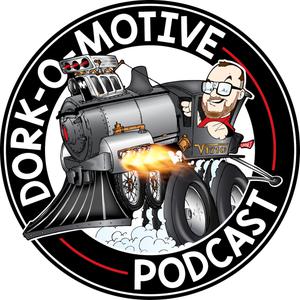
The Dork-O-Motive Podcast
Brian Lohnes
The ultimate gearhead history guide!
- 26 minutes 9 secondsBattling Beast of Burden: The Story Of The Massive M26 Dragon Wagon Truck of WWII
This is the in-depth history of what I believe to be the greatest heavy duty truck of the second world war. The M26 tank retriever was a machine designed with armor, with an engine of 1,090ci, with brute strength, and above all, with loads of practical engineering built in.
The truck out-performed every other rig in this role worldwide and was just beyond cool. With nearly 1,400 produced between 1942 and 1945, many still exist today in the hands of collectors and more. Learn the fascinating story of the small forgotten company that designed it, the massive company that built it, and the fascinating engine company that powered it.
Mechanical history rules!
7 October 2024, 4:51 pm - 19 minutes 46 secondsWar Hemi: The Story of Ford's 1,100ci Aluminum WWII GAA V8
It's a stunning thing to realize that Ford mass-produced an 1,100ci, dual overhead camshaft, alunimum block, flat plane crank V8 in the 1940s. Sill the largest mass produced V8 engine ever, it was just what Uncle Sam needed to power Sherman tanks.
But how did it come about? In this video we not only look at the awesome specs and mechanical feats that this engine is known for, we also look into its murky and wild history.
A history intertwined with international governments, shifty deal makers, and perhaps a little big of industrial espionage mixed in. Far more than just an engine, the GAA is a fascinating piece of American mechanical history which in some ways is still unrivaled more than 80 years later.
24 September 2024, 8:33 pm - 40 minutes 10 secondsDrag Racing's Mad Scientist: The Beautiful Mind Of Sneaky Pete Robinson
This is the story of one of the greatest minds in the history of the sport of drag racing. Lew Russell Robinson known more widely as "Sneaky Pete" Robinson was an innovator without equal in the 1960s. He approached the sport as a trained engineer from Georgia Tech and took that education to speeds and performance unknown for his time.
He was the type of guy they write rules to slow down, to save from themselves and to prevent lesser talented people from trying to venture down avenues they have no business entering. Robinson's 10 year run in the sport both in top gas and top fuel place him among the greatest not just of his generation, but of any generation. His use of simplicity and light weight made him the Colin Chapman of drag racing.
His unique and off-the-wall ideas, rooted in aerospace engineering are the stuff of legend and don't seem real until you actually see them. Understand that had Pete Robinson not lost his life in a 1971 crash he would have gone one to likely be an incredible drag racing crew chief, innovator in open wheel racing, and the high performance aftermarket.
This is the story of drag racing's mad scientist, "Sneaky Pete" Robinson.
9 September 2024, 12:03 pm - 34 minutes 46 secondsTwo Engines and No Chance: Al Stein's Twin Engine Porsche Indy Car Was Homebuilt Perfection
The Indy 500 has long been recognized as one of the most amazing hot beds of racing innovation in history. The 1966 race saw a car that may well stand as one of the most unique, inventive, and downright odd of the era. The Stein-Valvoline Special was a twin Porsche engined, four wheel drive, California garage built machine from the mind of a former midget racing champion and his friends.
The story of this car, its driver, and their attempt to qualify at the insanely jam packed 1966 Indy 500 is one every hardcore racing fan should know.
9 September 2024, 11:56 am - 1 hour 6 minutes4.3 The Greatest Race You've Never Heard Of: A History of Bahamas Speed Week 1954-1966
Every winter for 13 years between 1954 and 1966 the greatest sports cars as well as the greatest sports car drivers in the world would gather in the Bahamas for what may well have been the coolest racing event in history.
10 days of partying, racing, hanging out on the beach, and enjoying life with some of the world's greatest stars is just as awesome as you think it is. Racers like Stirling Moss, AJ Foyt, Mario Andretti, Phil Hill, Masten Gregory, Roger Penske, Carrol Shelby and others showed up year in and year out to battle for the money and glory in the world's coolest cars.
The first ever 427 Cobra race car debuted at this event, Duntov brought the Gran Sport Corvettes, Ferrari, Porsche, and on and on it goes.
The history is interesting, led by a tyrant named Red Crise the event was his idea and with a unique combo of an iron fist on one side and a velvet gloved Baronet's hand on the other, he made magic.
This is the fantastic story of Bahamas Speed Week.
25 February 2024, 1:49 pm - 36 minutes 41 seconds4.2 The Wild History Of INDOOR Drag Racing In Chicago During The 1960s!
During three winters in the 1960s, hot rodders in Chicago had the unique opportunity to do something no one has been able to do before or since. They went drag racing indoors. The didn't just do it once or twice, they did it weekly. How? Where? Why? Who put it together?
The story actually begins in the 1930s and the indoor drag strip followed go kart racing, midget car racing, even a road course indoors! The promoter, a man named Bill Schade is a story in and unto himself.
This is a story of the city of Chicago, a brilliant promoter, and a hot rodding culture starved for action in the winter. Enjoy!
9 February 2024, 7:37 pm - 1 hour 7 minutes4.1 Drag Racing's Darkest Day: The 1969 Yellow River Drag Strip Disaster
In early March of 1969, the single worst disaster in the history of American motorsports took place at a small, virtually unknown drag strip in rural Georgia. Yellow River Drag Strip was the scene of horror as a funny car flew off the racing surface and into the unprotected crowd. A dozen people died and scores were injured.
In this episode of the Dork-O-Motive podcast, we tell the story in every way possible. The history of the track, the history of the poeple involved, the immediate aftermath of the incident, how it changed motorsports in America, and so much more.
This is a bleak day for racing and one that carried with it very, very significant consequences.
5 February 2024, 7:49 pm - 1 hour 32 minutes3.7 Origin Story: How Stock Car Racing Was Born In Los Angeles Circa 1934!
You think you know, but you have no idea. Stock car racing in the United States was born in the south, but not the south you are think of. On this episode of the Dork-O-Motive podcast, host Brian Lohnes tells the story of the first true stock car race as we know it in America, the 1934 Mines Field Gilmore Cup race.
The greatest stars of racing were gathered to compete against one another in "stock" automobiles. There was cheating, there was a wild promoter, and there was more star power in one place than the racing world had ever seen.
Learn the full story of how this race changed American motorsports and understand how deadly, daring, and downright dangerous auto racing was in this era. Loads of research, period materials, and information was gathered for this exhaustive look at a race that truly changed the world.
7 September 2023, 5:38 pm - 2 hours 50 minutes3.6: Consumed: The First Ferris Wheel and How It Ruined The Life Of George Washington Ferris
What if I told you that the first Ferris wheel, built in 1893 was 265ft tall, powered by a 1,000hp steam engine, and carried 2,160 people at the same time! George Washington Gale Ferris is the man who engineered this marvel and the man who's name is synonymous with this ever-present attraction at fairs and amusement parks.
What if I told you that the machine simultaneously made Ferris a world-wide celebrity while destroying his life. This is a story with so many twists and turns you'll hardly believe it.
It is a fascinating look at the way engineering and the American spirit converged in the late 1800s to help the fledgling country arrive on the world stage and how anyone, even someone as smart as Ferris can become obsessed to the point of destruction in their personal and professional pursuits.
Did Ferris steal the idea? Where did it come from, anyway? How was it HIM that got the glory? All those questions and the amazing size of the machine are all covered here!
29 June 2023, 4:17 pm - 1 hour 36 minutes3.5: Cold War Crushers: The Awesome History of The Air Force Heavy Press Program
The US Air Force Heavy Press program, executed between 1950 and 1957 is one of the most incredible industrial achievements in history. After identifying a huge technology gap at the end of WWII, the government worked with private industry to create the world's most extensive network of heavy press capability. The machines are insane, the work they do is even cooler, and the effort it took to create them is off the charts.
One of the most successful industrial programs ever, 8 of the 10 heavy presses of the 1950s are still working today, making parts for everything from cars to stealth aircraft. Here's the story told the Dork-O-Motive way!
17 March 2023, 1:08 pm - 2 hours 15 minutes3.4: Fastest - An Oral History of the 1992 Hot Rod Magazine Fastest Street Car Shootout
In 1992 Hot Rod Magazine gathered a collection of the fastest street cars in America for a showdown in Memphis, Tennessee. The reverberations of this event are still being felt today as it helped to rocket the movement of "fast street cars" into the hot rodding stratosphere. This is the story of that event, as told be the editors, racers, and fans that were there.
Some of the guests on this show remember the race fondly, some with regret, and some, frankly, with their teeth gritted together, even 30 years later. It is a story about an event that changed the course of drag racing, changed the course of lives, and ultimately created things like Drag Week, Sick Week, Rocky Mountain Race Week, and the entire genre of Drag-n-Drive competition.
17 December 2022, 5:20 pm - More Episodes? Get the App
Your feedback is valuable to us. Should you encounter any bugs, glitches, lack of functionality or other problems, please email us on [email protected] or join Moon.FM Telegram Group where you can talk directly to the dev team who are happy to answer any queries.
 Dinner with Racers
Dinner with Racers
 The Diesel Podcast
The Diesel Podcast
 Past Gas by Donut Media
Past Gas by Donut Media
 CarCast
CarCast
 The Smoking Tire
The Smoking Tire
 The Dale Jr. Download
The Dale Jr. Download